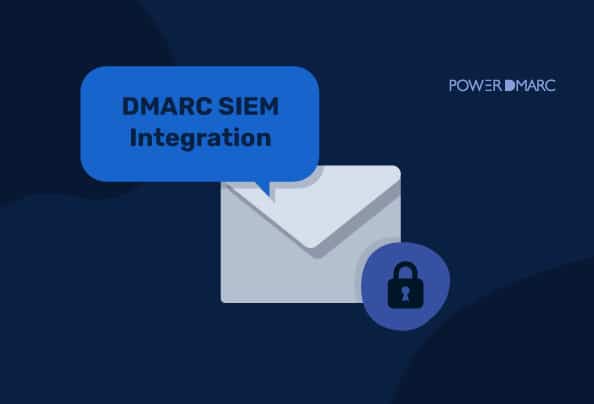DMARC SIEM integration is the process of connecting your company’s existing SIEM solution to another system, like an incident management system or a threat intelligence platform, or an email security solution, like in this case: DMARC. When you connect them, they can share data in real time so that each one has a complete picture of what’s going on. A lot of companies rely on security information and event management (SIEM) solutions to help them keep track of their cybersecurity efforts.
Security Information and Event Management (SIEM) – Explained
Security information and event management (SIEM) solutions are designed to help you manage your organization’s security systems. They collect data from all of your systems, including the firewall, anti-virus software, intrusion prevention system (IPS), anti-malware software, and more. This data can be used to monitor your network for threats or suspicious activity.
SIEM solutions are beneficial because they help you identify problems before they happen. If a device on your network starts acting up, it can alert you so that you can take action before anything else goes wrong. This means that when an incident does occur, you can immediately respond and mitigate the damage before it’s too late.
The Need for SIEM Integration
SIEM integration is a way for businesses to manage their security tools by connecting them together and analyzing the data from each tool. It’s like having one dashboard where you can see all your security tools at once—and even better than that because it makes it easier to quickly identify threats and respond to them.
When you integrate your SIEM with other security tools like firewalls or endpoint protection systems, you can see all activity across all devices—so if something happens on one device or location, it will show up in a single place. This means you don’t have to check multiple dashboards or reports anymore. You’ll be able to see everything at once so you know what’s going on in real-time.
SIEMs can be deployed on-premise or in the cloud, depending on your needs and budget. Deploying them in the cloud has some benefits, such as reducing costs by not having to purchase (and maintain) hardware and software, but it comes with its own set of challenges related to security, uptime, and performance.
Things to keep in mind
If you’re thinking about deploying a SIEM solution, keep these three things in mind:
- Do your research – There are many SIEM products available today, so make sure you understand what they offer before deciding which one works best for your organization.
- Think about how many users will need access – If there are multiple teams working together on the same project then they will each need access to the data being collected by the SIEM solution.
- Keep it simple – While having all of this information at your fingertips sounds great on paper, trying to analyze everything at once can lead to information overload or even paralysis by analysis!
DMARC SIEM Integration
For most organizations, implementing and maintaining a robust, scalable, and effective email security program can be a daunting task. In today’s environment of increasing cyber threats, it is imperative for organizations to have an effective email security program in place. However, many organizations are still struggling with how to make DMARC a part of their existing security operations.
DMARC is a powerful tool for fighting against phishing, but it can be hard to implement. Here are some tips to help you integrate DMARC into your existing security operations with SIEM integration:
- Understand the basics of DMARC:
DMARC (Domain-based Message Authentication, Reporting & Conformance) is an email authentication protocol that’s meant to prevent phishing and fraudulent emails from being delivered to end users. It does this by allowing companies to specify what should happen if a message fails DMARC validation; this could be anything from rejecting the message entirely to sending it on as normal.
- Make sure your DNS configuration is correct:
Before you even begin configuring DMARC, make sure that your DNS settings are correct—this means ensuring that SPF and/or DKIM records are set up properly. If they’re not, DMARC will not work as intended.
- Set up SPF records:
SPF stands for Sender Policy Framework, and it’s an email authentication method used by ISPs and other mail servers to prevent spoofing of sender addresses in emails (i.e., when an email appears as though it came from someone other than who actually sent the message).
- Use a DMARC provider with API Support
To successfully include DMARC in your SIEM integration strategy, an API-supported platform is your best bet! At PowerDMARC, we provide seamless SIEM integration with all of your favorite third-party security tools and services (e.g. your firewall and antivirus) through DMARC API.
Why keep DMARC in your SIEM Strategy?
Keeping DMARC in your SIEM integration strategy as a layer of email security can be beneficial in the following ways:
- DMARC helps you monitor your email channels via a reporting system
- Prevents phishing and spoofing attacks
- Acts as a defensive layer against ransomware
- Improves email deliverability and reduces spam
To implement DMARC today, we recommend configuring a DMARC analyzer for your domains. It makes protocol configuration easy and error-free, takes away the complications involved in maintaining and managing security systems, and provides well-rounded protection to your emails.
- How to Setup DMARC in Office 365? Step-by-Step Guide - May 6, 2024
- SMTP Yahoo Error Codes Explained - May 1, 2024
- SPF Softfail Vs Hardfail: What’s the Difference? - April 26, 2024
